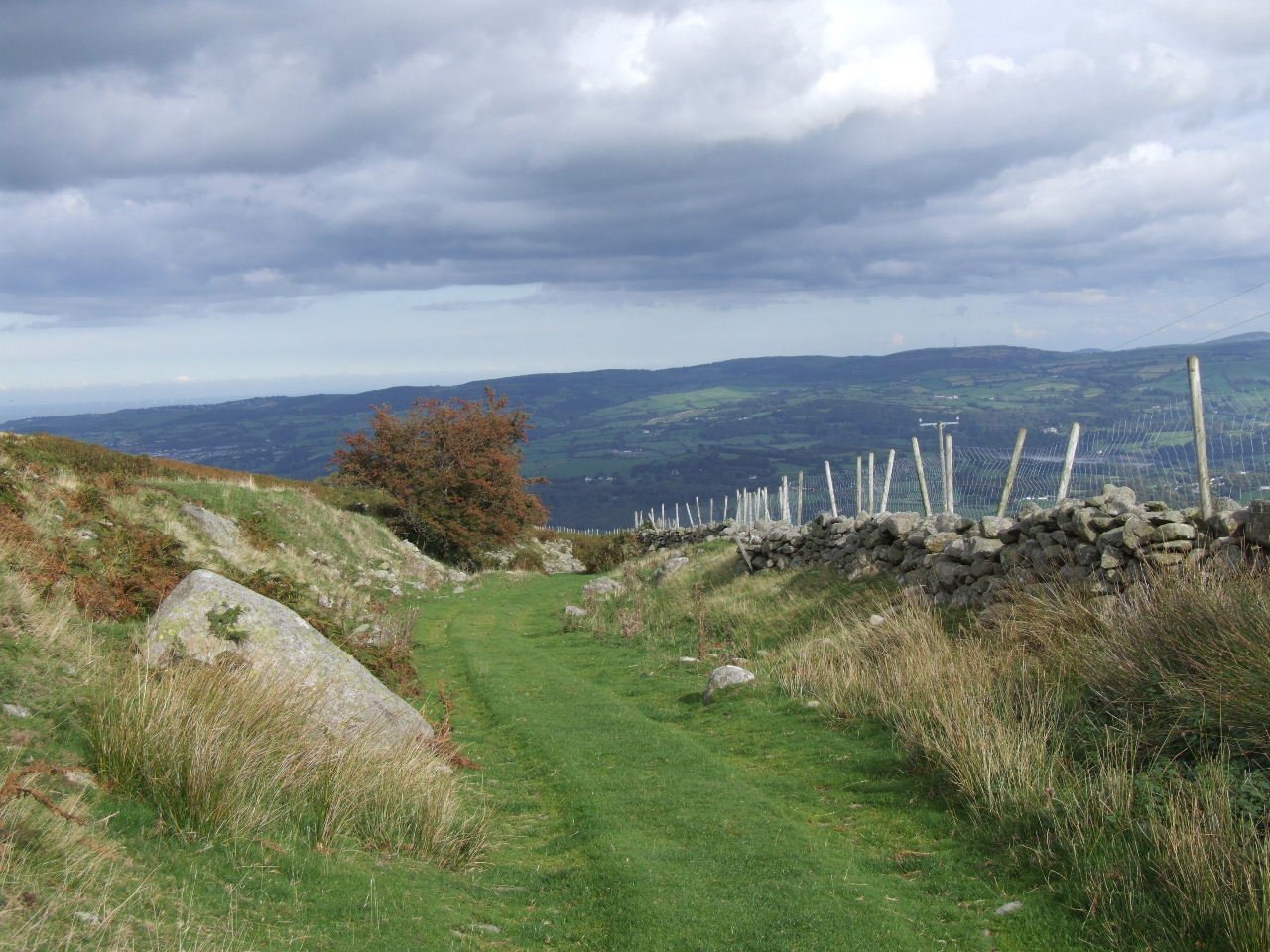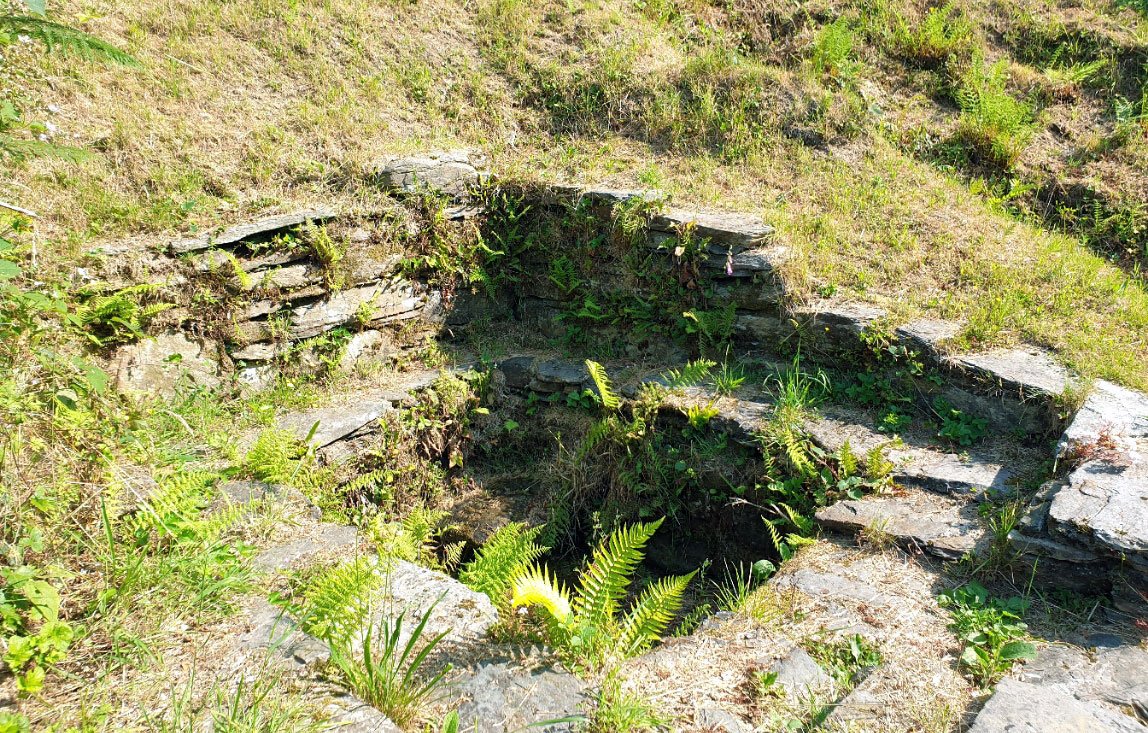Seeking Elen

Whoso list to hunt, I know where is an hind1
Sir Thomas Wyatt, 1503–1542

Elen Luyddog, or Elen of the Hosts as she was known, built roads the length of Wales, many of which can still be seen, usually signposted “Sarn Helen” or “Sarn Elen”, sarn meaning causeway or road. Mining and agriculture have destroyed many sections, while others remain as green lanes or delightful sunken paths. Some are buried under major roads like the A5. I visited one section at the Roman fort of Tomen-y-mur and could still make out the shape of the road and hear my boots on the stones. Easy, there, to imagine entire cohorts of Romans marching along in their hobnailed sandals.

Section of Roman road, Conwy
Macsen, otherwise known as the Emperor Maximus of Rome, was out hunting one day and fell asleep when he stopped to rest at noon, whereupon he had a remarkable dream in which he travelled to an unknown country. He boarded a ship from a large fleet, which took him to a fair island and eventually to a castle, which he entered. He saw within a great hall, of which the roof and doors seemed to be made of gold. Two auburn-haired young men were playing a board game with golden pieces and there was also an older man wearing a gold torc and seated in a chair with two eagles of reddish gold figured upon it. Macsen also saw a maiden sitting in a chair of reddish gold; she was almost too bright to look at, so beautiful was she. She wore a golden surcoat, with red gold on her head and a girdle of the same colour. Elen – for that was the maiden’s name, stood to greet him and immediately he embraced her and they sat down together – but then he awoke, feeling desperate to find the maiden again, as he loved her already.
Messengers were sent to seek out the maiden and some eventually came to the castle and entered the hall. They saw the maiden and knelt at her feet, addressing her as Empress of Rome. She thought at first they were mocking her but they explained, whereupon the lady said that if the emperor loved her he should come himself to fetch her – which Maximus did.
After their wedding night Elen claimed her morning gift, as all brides were entitled to do. She requested the island of Britain for her father and for herself three major forts, to be built at locations of her choosing. Then Elen decided that roads should be built between each of these forts and because of this the roads were called Ffyrdd Elen Luyddog – the roads of Elen of the Hosts.
Macsen is a known historical figure. Magnus Maximus, to give him his Roman name, had served in Britain from 367 to 383, when he was proclaimed emperor by his troops, whereupon he crossed the Channel and established himself as Emperor in the West. His reign was short as he attempted to move against Italy in 387 and was executed by Theodosius I in 388.
Macsen’s Dream and the events that follow are all about sovereignty: the morning gifts of land and of forts to defend it make that clear. The dream has been described as an aisling, a particular kind of vision in which a woman who represents Sovereignty appears, in this case the bright, shining Elen. It’s also noteworthy that, as Caitlín Matthews points out, the gaming board described in many translations of Macsen’s Dream as a chessboard was in fact for an older British game called gwyddhwyll – “wood wisdom” and this board represented the land itself…4. A Goddess of Sovereignty is certainly not submissive, adds Matthews, and Elen makes it clear that if Macsen loves her as he says then he must come to her, to her land and country.
It would be difficult to miss the many mentions of gold in the story of Macsen’s dream and of course one reason the Romans came to Britain was to appropriate its mineral wealth of gold, copper, tin and lead. In this context, then, it’s worth noting that Maximus was probably a Celt from Callaecia (modern Galicia) in northwest Spain, an area famous for its gold mines. He may well originally have been sent to Britain because of some expertise in mining gold; even today Welsh gold from the Clogau mine near Dolgellau is particularly valuable because of its unusual rose colour and much is thought to remain underground. As Caroline Wise writes: “Gold lies beneath our feet as we walk Elen’s old roads.”5
Any baby name book will tell you that the name Elen can mean bright or shining but the word is also very similar to the Proto-Indo-European *h1el-6, meaning the colours grey or brown, or it can also mean deer. Today words derived from this can be found in many European languages, to name but a few: Bulgarian elen, which means deer, Irish eilit, meaning doe. In Polish, jelen is the word for deer, while in Lithuanian álnis means deer.
Long before the arrival of the Romans, writes Judith Shaw7, Elen was the Guardian of the Leys, the ancient trackways, leading the way on the migratory paths of reindeer – they probably migrated out of Britain and France when the Boreal Forest, which extends all around the world to the far north, itself moved north around 10,000 BCE as the Ice Age drew to a close. Britain was still joined to the mainland until about 8,500 years ago or maybe a little longer, and so it was indeed perfectly possible to walk from Wales to Siberia. Indeed, the most recent reindeer remains found in Britain to date were from a site in Sutherland in the Scottish Highlands, dated to 8,300 years ago, which fits in very well with the dates given above.
Our ancestors knew the old migration trails of animals, writes Elen Sentier8 and reindeer follow the grandmother deer along ancient tracks, while people, in turn, follow them, as Sami people in the Nordic countries today still do. It’s said that their shamans, called noaidi, could fly through the sky or swim the rivers as wild reindeer. Perhaps that is what the swimming reindeer sculpture pictured below, which was found in southern France and dates from around 11,000 BCE, portrays?

There may be other dim memories of reindeer in Britain: in the Abbots Bromley Horn Dance, which takes place in September each year, the horns used in the dance are actually reindeer antlers dated to the 11th century and probably imported from Scandinavia – there is no evidence of reindeer remaining in Britain at that time. The question here is why did the antlers need to be imported, unless it was in some way important that they were from reindeer?

Ffynnon Elen
Often, in the old tales and songs, the Sovereignty Goddess shifts her shape and leads the would-be husband/king a merry chase, while today we often think only of deer as creatures to be hunted. For a long time the connection to kingship was seen only to be that hunting had become the prerogative of royals and nobles, as is suggested by Thomas Wyatt in the poem quoted at the beginning of this piece. (Whoso list to hunt… means “whoever is ready to hunt”.) Wyatt might have been a courtier of Henry VIII, but was arrested and came near to execution after Anne Boleyn’s downfall, along with other men thought to have been her lovers. Later in Wyatt’s poem we’re told that “Caesar” has asserted his right to the hind, leaving little room for any interpretation other than that the king has claimed Wyatt’s doe for his own. Anne Boleyn has fascinated us for centuries, perhaps because the glittering court she held with Henry in the early years meant that she still holds some of the magic, the glamour, of sovereignty, but in Tudor England the connection with deer and sovereignty had clearly weakened to the point where the animals were merely prey.
So much of the evidence, from Derfel’s “horse” to the clear connotations of sovereignty in the tales of Elen, plus the linguistic information and the existence of reindeer in Britain, for which we have direct indications in the form of the remains found, lead one to suspect a much earlier original date than those usually suggested, and it’s exciting and truly staggering to realise that Elen may well date back to the Stone Age. Rather like Ceridwen, another hugely important goddess in Wales, she is returning from the mists today as we find new ways to work with and honour our beautiful and ancient landscape.
Geraldine Charles
29 July 2021
2. Gray, M., 2013. Welsh History Month: St Derfel and the Stag – icon or idol?. [online] WalesOnline. Available at: <https://www.walesonline.co.uk/lifestyle/nostalgia/welsh-history-month-st-derfel-3316866> [Accessed 28 July 2021].
3. Kessler, P., 2021. The Mabinogion – The Dream of Macsen Wledig. [online] Historyfiles.co.uk. Available at: <https://www.historyfiles.co.uk/FeaturesBritain/BritishMabinogionStory5.htm> [Accessed 16 July 2021].
4. Matthews, C., 2002. King Arthur and the Goddess of the land. Rochester, Vt: Inner Traditions.
5. Wise C., (Editor) 2015. Finding Elen: the Quest for Elen of the Ways. Eala Press.
6. Proto Indo-European is a theoretical common ancestor of the Indo-European language family, which includes Greek, Latin, Celtic, Italic and Germanic language sub-families.
7. Shaw, J., 2016. Elen of the Ways by Judith Shaw. [online] Feminismandreligion.com. Available at: <https://feminismandreligion.com/2016/09/28/elen-of-the-ways-by-judith-shaw> [Accessed 26 July 2021].
8. Sentier, E., 2013. Shaman Pathways – Elen of the Ways. Winchester: Moon Books.
9 British Museum, CC BY 2.0 <https://creativecommons.org/licenses/by/2.0>, via Wikimedia Commons
10. Cantrell, J. and Rylance, A., 1992. Sarn Helen: Walking a Roman Road through Wales. Milnthorpe: Cicerone Press.
11. Newspapers.library.wales. 2021. DOLYDDELEN.|1875-12-03|The Cambrian News and Merionethshire Standard – Welsh Newspapers. [online] Available at: <https://newspapers.library.wales/view/3307701/3307709/73/dolyddelen> [Accessed 28 July 2021].

